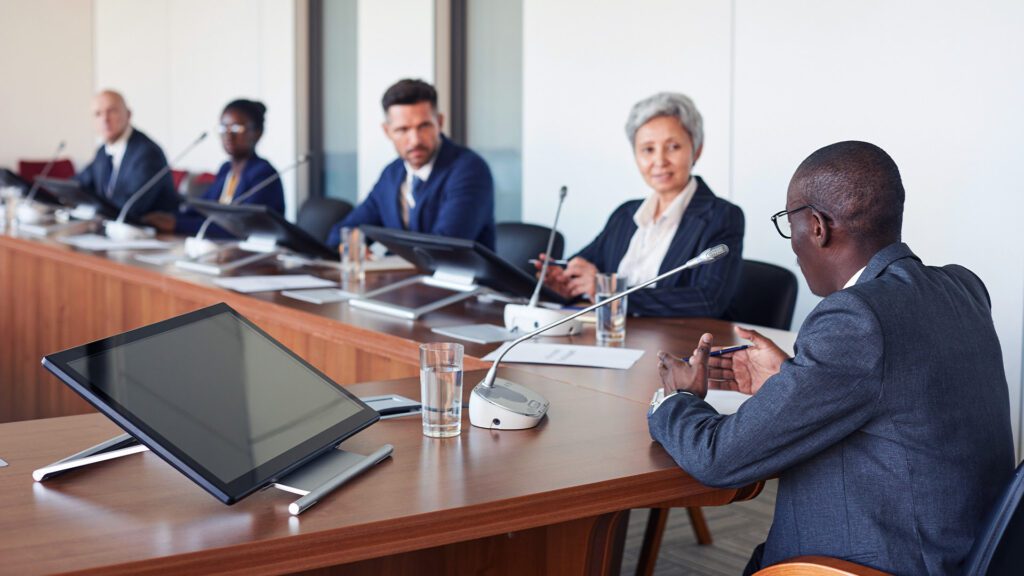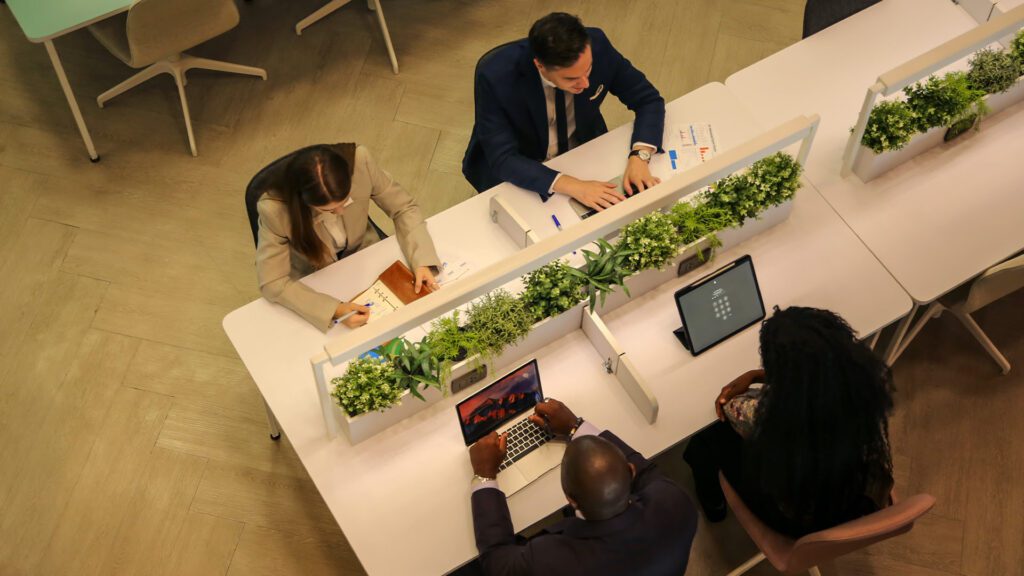By Ketan Kulkarni – Linkedin
In 2021, technology is not only fundamentally changing how industries function, but also the ecosystems they are a part of, in no small part due to the global pandemic. An organization can choose the degree to which they will embrace the purposeful evolution of their ecosystem in uncertain times. The organizations with the strongest embrace will see the other side while also leading the innovation of their industry. Such innovation is the domain of teams of highly collaborative teams versus the great insight of an individual innovator.
Transforming a Traditional Ecosystem
The Justice system is a traditional ecosystem with hardened processes (laws are about as hardened a process as you can get) and well-established training initiatives. Is it possible to apply new technology tools to realize drastic benefits?
The opportunity to improve communication lies in the application of technology, precisely because the processes are hardened and the training is well-ingrained into the traditional culture of Justice systems, wherever you look.
With this backdrop let’s see how the four categories below can be applied to the Justice ecosystem, transform it with collaborative technology and compound the ROI of the initial business case.
- Operational Savings
- Productivity Improvements
- Strategic Transformation

Operational Savings
The lowest hanging fruits in any ecosystem are operational savings. Operational savings are when you either stop doing something you used to do, or do it differently in a way that allows you get the same result but with less cost. Let’s take the remand process as an example.
Remanded inmates are individuals who do not qualify for bail and who instead are being held in pre-detention facilities, waiting to have their trial. When they are required to appear in front of a judge it is referred to as a remand appearance. Remand appearances require a lot of people and activity to conduct. Accused individuals typically need to spend an entire day being moved from the detention facility to the courtroom and then back. This requires accompanying guards (at least 2, sometimes up to 4), specialized vehicles for transport, all the costs of being away from the facility for the day – food, gas, etc., facilities at the courthouse to hold the prisoners until it is time for their hearing, and the risk of moving prisoners around is inherent in the undertaking.
Applying video conferencing technology to facilitate remand appearances is a perfect example of how substantial cost can be taken out of the ecosystem, maintaining the same end result.
The Operational Savings = Cost avoided / Cost of video conferencing technology
While it is difficult to obtain costs for all the components involved, here is a high level estimate of the costs that could be avoided:
| Costs Avoided |
|---|
| 1) Guards (avg. of 3) for a day = 3 x 8 hours x burdened hourly rate of Guards = 3 x 8 x $50 = $1,200 day |
| 2) Cost of transportation: specialized vehicle + expenses = $750/day |
| 3) Facilities requirements to handle prisoners in courthouse = $300/day |
So, one remand appearance is probably costing taxpayers at best about $2,000. Multiplied by the number of appearances in a year that could be delivered via technology ~ 14,000 x $2,000 = $28,000,000 / year. Over a 10-year period, that is $280,000,000. Even if the estimate for the cost of one remand appearance is 50% above actual costs, there is still significant opportunity to realize operational savings.
Investing in the infrastructure required to facilitate these hearings would be significantly less than the 10-year cost of doing it without technology. One of the key investments in this process is the technology in the courtroom that allows the remand appearances to be conducted remotely.
In any organizational ecosystem there are always rooms where people from different parts of the ecosystem come together to meet. In the judicial system, these are the courtrooms in the various courthouses across the country.
A courtroom is where the 4 different constituents (Judicial, Legal, Law Enforcement and Corrections) come together to conduct their trials and is the focal point for moving the judicial process forward. To enable new communications tools to change the processes, the courtrooms must be equipped with the technology required to conduct electronic communication, which are rich experiences – just like being there.
Productivity Improvements
Courtrooms that have been enabled in this way can now be much more productive in processing the courtroom workflow (the proceedings) – a must given the backlog created by the shutdown of physical locations as a result of the pandemic. A judge in court can hold remand appearances sequentially, connecting with prisoners who appear, via video, from various correctional facilities – one after another. The physical scheduling and logistics that used to be a key component of the “old method” suddenly becomes vastly simpler and less costly. The simplified scheduling and logistics of remand appearances through the use of video conferencing technology also increases the number of appearances processed. The beneficial results of doing this:
- Less facilities required for remand prisoners = less time required in remand facilities
- Greater use of the judge’s time, as well as other court personnel, and their ability to handle cases (therefore less judges and court personnel required)
- Less backlog of cases to be heard

The opportunity for greater productivity in the Justice ecosystem can be found in many other processes. Many jurisdictions have learned that leveraging video can reduce — or eliminate — many of the hidden delays and costs of the Justice system associated with logistics such as travel time for a variety of participants including witnesses, interpreters, attorneys and inmates. In an ecosystem where everyone wants to talk to the inmate (prosecutors, probation officers, public defenders, judges, etc.) easier access via video can accelerate workflow.
- Judges can hold sessions across a wide variety of locations one after the other all from the courtroom or chambers
- Cases get processed faster – no delay waiting for critical mass of cases in remote locations
- Bail hearings can be enabled by video
- Plea bargains can be implemented much faster (don’t need a 2 hour process to get into the jail to see prisoner), which means less time in jail for visitors and less requirements for facilities
- Access to justice – inmates can access attorneys and other legal aid remotely, which includes the benefit of upholding social distancing guidelines
- Video testimony – expert witness (can greatly reduce cost),
- Vulnerable witness – appearing in court is dangerous, disruptive and disturbing but their testimony can be critical; video makes it easier
- Interpreters – can handle multiple sessions just minutes apart in different locations. Therefore overall need goes down because of the tremendous compression of time.
- Telemedicine and educational programs in prisons
- Visitation
Clearly these productivity improvements, which were not planned for as part of the initial business case, would likely add even more financial benefits. Often, the productivity benefits that are realized in an ecosystem will quickly outweigh the operational savings provided.
Strategic Transformation
As new communications infrastructure and endpoints have been put in place over recent years – a process accelerated by the pandemic – the Justice ecosystem is being unintentionally transformed with far greater capability than was initially envisioned. The people who are using the new communications tools will start to apply the same tools to situations that were never envisioned at the start of the ecosystem’s transformation.
Let’s look at three real life examples of strategic transformation in the Justice ecosystem:
1) International Trials
With the globalization of business, there are now occasions where the globalization of court communications could greatly help the operation and productivity of trials that happen where multiple countries are involved. Our company, ET Group, facilitated a trial like this where two courtrooms in two different countries were in a single combined session at exactly the same time. The benefits were substantial:
- Air travel was substantially reduced
- Lawyer’s monetary and timespend costs for that travel were eliminated
- The proceedings were able to progress faster because both courtrooms in both countries were connected to each other in real time.
One court session brought together two different jurisdictions simultaneously.

2) Virtual Meeting Rooms (VMRs)
The use of VMRs in a collaborative ecosystem typically happens at a later stage in the development of the ecosystem. VMRs are very powerful because they can:
- Drastically reduce costs
- Drastically accelerate the workflow (the velocity of collaboration) of both existing processes and re-engineered processes
In the Justice ecosystem a perfect example of using VMRs would be to allow the general public to pay their traffic tickets with a hearing in a VMR. When you use a VMR you don’t need a courtroom (massive cost savings), and you allow a person who received the traffic ticket to call into the VMR for their trial. The judge, the officer, the lawyer (if required) and the defendant would all be participants in the VMR. The result is significant savings in travel costs for all involved.
Using VMRs as described in the traffic ticket scenario above would also require software which would would mimic the workflow of the traffic court. People would need to check in online, be held in a queue waiting to see the judge in the VMR with the other participants. But over time this additional expense stands to be minimal compared to what could be saved through the strategic use of VMRs within the Justice collaborative ecosystem.
3) Collaborative Portals
With technology infrastructure in place, new functionalities can be implemented that were not possible before. With software, recordings of the courtroom proceedings can now be captured in a way that was not previously possible. Video and audio streams can be recorded simultaneously from the different cameras and microphones in the courtroom and can be captured as the record of the court. These court records can be:
- Instantly archived in the courtroom, with two layers of back-up (courthouse and datacenter)
- Instantly retrieved whenever required by authorized personnel
- Transcripted instantly
- Distributed with different pieces redacted in the recording, depending on who needs to review the record
- Used as evidence in a court of law and have the veracity to stand up to any challenges
- Be used in an online secure portal for authorized personnel to collaborate by reviewing and commenting on the record
Extending capabilities leverages the initial investment in technology already in place and further accelerates the velocity of collaboration in the Justice ecosystem, thus compounding the initial investment.
There are more than just these three strategic transformation examples which stand to further influence the business case for investment in a new collaborative technology platform. Being able to continue to conduct business and enable access to justice for citizens using VMRs in the face of a global pandemic – in some cases more than ever before – is a prime example.
Conclusion
The natural evolution of a collaborative ecosystem is to capture operational savings first, then to realize productivity gains as a by-product through the extension of the technology to new processes, and finally, hit the home runs through the strategic transformation of the ecosystem.
It takes considerable fortitude by those steering the ecosystem to make the investment without truly understanding how the ecosystem will function when the collaborative technology is fully implemented and enabled. They must resist the temptation to cut corners and compromise on the building of the platform that will become the foundation for transformation for years (if not decades) to come.
All its woes aside, COVID-19 helped accelerate a fundamental systemic change that was already occurring – one that has now proven itself here to stay. The technology stakeholders in Justice systems around the globe would do well to take notice.







